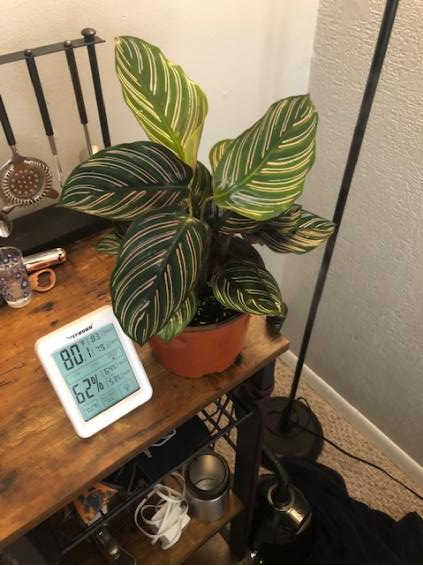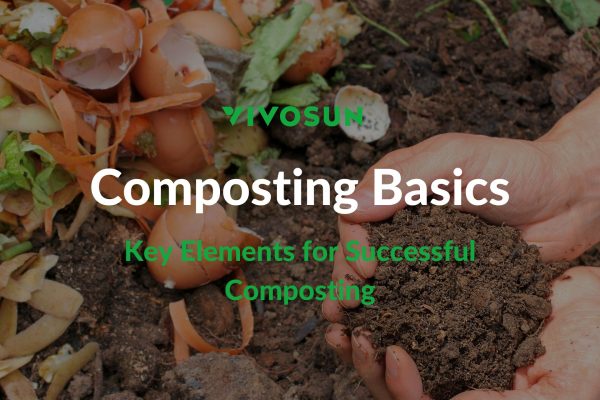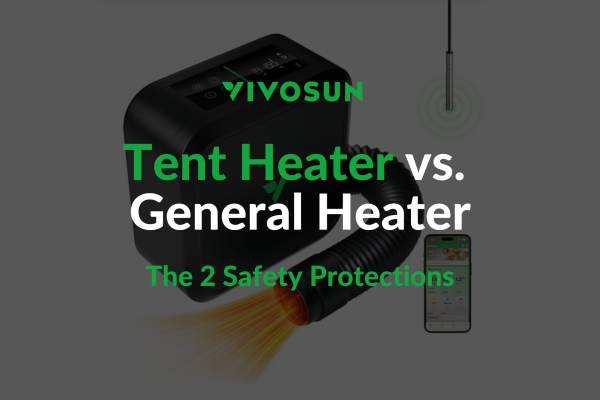Table of Contents
Your grow tent is the home of your plants and whether the home is large or small, you need to maintain a proper environment for them. Humidity is one of the keys to keeping plants happy and growing. If you’re an indoor grower, you’ll need to learn how to control and increase humidity in a grow tent.
What is Humidity?
Humidity is the measure of water vapor concentration in the air, reflecting the moisture content of the atmosphere. Typically expressed as a percentage, it indicates the proportion of water vapor present relative to the maximum capacity the air can hold at a specific temperature and pressure.
To measure humidity in your grow tent, the easiest way is to use a digital hygrometer, which makes readings and monitoring quick and easy. If you want to keep your plants healthy and for them to live longer, you will need to control the humidity levels to a point between 45% to 75% relative humidity (RH). If your grow tent is below 40% RH, you have to take action to increase the humidity, otherwise, there will be a high risk of losing your plants.
Humidity levels below 40% RH can be dangerous for most plants because it causes plants to lose their reserve water, causing them to wilt faster, grow slower, lose nutrients, and ultimately they will die. It can also lead to poor development and lower yields in the long run.
Some plants and some grow periods require very high humidity levels, such as during the seedling or cutting periods. When you move to these stages, be sure to raise the humidity in a grow tent. The difficulty is that humidity is not easy to control, so we came up with a couple of ideas for how you can increase the humidity in the grow tent.

What is Relative Humidity?
Relative humidity (RH) is a measure of the amount of water vapor present in the air relative to the maximum amount of water vapor the air can hold at a given temperature and pressure. It is expressed as a percentage and indicates how close the air is to saturation.
Relative humidity is affected by both the actual water vapor content in the air and the air temperature. Warm air can hold more water vapor than cold air, so relative humidity values change with temperature fluctuations. For example, if the relative humidity is 50%, it means the air is holding half of the maximum amount of water vapor it can hold at that temperature.
What is Absolute Humidity?
Absolute humidity (AH) is a measure of the actual amount of water vapor present in the air, regardless of temperature. It is expressed in grams of water vapor per cubic meter of air (g/m³) or other units of mass per volume.
Unlike relative humidity, absolute humidity does not change with temperature variations. It represents the total moisture content in the air and is often used in meteorology and engineering applications. Absolute humidity provides a more direct measurement of the moisture content in the air but does not provide information about the air’s saturation level.
Ways of Increasing Humidity in a Grow Tent
1. Adding a bucket of water
Since humidity is water vapor, you can add a bucket of water or several small bowls of water into your grow tent. As the water evaporates you will raise the humidity level in the tent. Be sure to refill the water when necessary.
2. Watering the plant by using a sprayer
Using a spray, mist the air inside the grow tent multiple times. As the water droplets evaporate, they will raise the humidity level inside the tent. In order to keep the humidity at a constant level, mist the leaves and roots of your plants every day. Check the RH every morning. If the humidity level falls too much, be sure to mist the plants again.
3. Hanging wet towels
Just as in the other methods, hanging a big wet towel or several small wet towels in your grow tent will make water evaporate in the air. This is an easy way of increasing the humidity level. Remember, make sure the towels are not too close to your grow light or other heat sources, since the towels could be burned.
4. Removing the grow lights
Grow lights can create a lot of heat so removing them will decrease the ambient heat level within the grow tent. Less heat will help the air retain humidity. As an aside, it is important to find a proper balance between heat and humidity.
5. Lowering your fan’s speed
Air circulation reduces the ambient humidity in your grow tent by pulling or pushing the moisture trapped in the air. By keeping your fan at a medium or low speed you will be able to stabilize humidity levels while keeping fresh air circulating in the tent. Alternatively, you can also shut off the ventilation system temporarily—for an hour or two—to help the humidity level stabilize.
6. Reducing the air conditioner’s temperature
Decreasing the temperature in the room can raise humidity as well. Using an air conditioner is an easy way to increase the humidity without adding any extra water. However, some plants do not prefer cool environments, so be careful with your plants. It is always a good idea to have a thermometer in the tent with your plants so you can keep an eye on the temperature, regardless of the humidity.
7. Using a humidifier
The most obvious way to increase the humidity in a grow tent is to use a humidifier. A humidifier is a small device that is easy to use, just fill the water tank and turn on the device and over time it will fill the air with water vapor.
8. Adding more plants
Plants respirate similarly to animals, and part of what they “exhale” is water vapor. This transpiration results in raising the humidity in a grow tent. Adding more plants to a grow tent will increase transpiration and bring humidity levels up. You can add plants other than your main crop, too! It’s an excellent opportunity to try something new.
Wrap-up
Every plant has its preferred humidity levels—whether you’re growing orchids or succulents, you will need to mimic the perfect growing environment for your crop. Yet, humidity levels vary through stages of growth, so you will need to carefully measure and adjust humidity through the growing cycle to accommodate your plants’ changing needs.
Luckily, there are some quick and easy ways to make these adjustments—just make sure you know the needs of your specific plant or specific strain before you grow so you can plan accordingly. Happy growing everybody!
If you have any questions, please don’t hesitate to reach out to us!
And be sure to check out our other blog posts for useful tips on becoming a great grower!
Subscribe to the VIVOSUN newsletter for growing tips, grower stories, and special offers, and get 12% off your first order!
We love the new VIVOSUN Smart Grow System and we are certain that you too will love it once you try it.
And join our Facebook farmer’s community for even more exclusive contests and prizes!
Download VIVOSUN App to get 18% off and explore more information!

How to increase humidity for plants?
- Pebble Trays/Humidity Trays: Place a waterproof tray filled with pebbles or gravel, and add water to just below the top of the pebbles. As the water evaporates, it will release moisture into the air around your plants.
- Group Plants Together: Grouping plants together creates a microclimate where they can transpire and raise humidity levels for each other.
- Mist the Leaves: Use a spray bottle to mist the leaves of your plants with room-temperature water. The moisture on the leaves will slowly evaporate, increasing humidity.
- Use a Humidifier: Set up a humidifier near your plants and adjust the settings to achieve the desired humidity level, typically between 50-60% for most houseplants.
- Place Bowls of Water Nearby: Strategic placement of bowls or trays of water near your plants will allow the water to evaporate and humidify the air.
- Cover the Soil with Moss or Pebbles: This prevents water from evaporating too quickly from the soil and helps retain moisture in the air around your plants.
- Create a Mini-Greenhouse: For smaller plants, place them together in a clear plastic container or terrarium to trap the moisture they release.
- Hang Damp Towels: Hang clean, damp towels or cloths near your plants, and the evaporating water will increase humidity.
How do I raise the humidity in my grow tent without a humidifier?
- Use wet towels or sponges:
- Place wet towels or sponges around the grow tent. As the water evaporates, it will increase the humidity levels.
- Make sure to re-wet the towels or sponges regularly.
- Create a pebble tray:
- Place a shallow tray filled with pebbles or rocks at the bottom of the grow tent.
- Pour water into the tray, making sure the water level is below the top of the pebbles.
- As the water evaporates, it will increase the humidity in the tent.
- Mist the plants:
- Use a spray bottle to mist the leaves and soil of your plants regularly.
- The water that evaporates from the leaves and soil will raise the humidity.
- Use a humidity dome or mini greenhouse:
- For seedlings or clones, use a humidity dome or mini greenhouse to trap moisture around the plants.
- Increase the number of plants:
- More plants in the grow tent will transpire more water vapor, naturally increasing humidity.
- Use a water reservoir:
- Place an open container or reservoir of water in the grow tent. As the water evaporates, it will humidify the air.
Can I use natural methods to control humidity?
Yes, there are some natural methods you can try to help control humidity levels in your grow tent.
- Grow moisture-loving plants: Certain plants like ferns, mosses, and tropicals release more moisture into the air through transpiration. Having these types of humidity-loving plants in your grow tent can help raise humidity levels naturally.
- Use humidity trays/saucers: Place shallow trays or saucers filled with gravel or pebbles under your potted plants. Add water to the trays, making sure the water level is below the top of the gravel/pebbles. As the water evaporates, it will increase humidity.
- Hang wet towels/burlap: Hang wet towels or pieces of burlap inside the tent. As they slowly dry out, they will release moisture into the air.
- Mulch your soil: Using an organic mulch like coconut coir or sphagnum moss can help retain moisture in the soil, increasing evaporative humidity.
- Mist plants manually: Use a spray bottle to periodically mist the leaves and soil of your plants with water. The evaporating water will humidify the air.
- Allow soil to dry between waterings: Don’t over-water your plants – allow the top inch or two of soil to dry out between waterings, as wet soil contributes humidity.
Is a humidifier necessary for all types of plants?
No, a humidifier is not necessary for all types of plants. The need for additional humidity depends on the specific plant species and the environmental conditions they are grown in.
Some plants, especially those native to tropical or humid environments, do benefit from increased humidity levels. Examples include:
- Tropical plants (orchids, ferns, begonias)
- Humidity-loving houseplants (calatheas, monsteras, alocasias)
- Plants grown in very dry indoor environments
For these plants, a humidifier can help prevent dried leaf tips, increase growth rates, and discourage pests like spider mites that thrive in dry conditions.
However, many other plants, especially those from arid or temperate regions, can tolerate or even prefer lower humidity levels. Examples:
- Cacti and succulents
- Mediterranean herbs
- Many indoor flowering plants
For these plants, ambient humidity in a typical home environment is usually sufficient. Adding extra humidity could lead to problems like mold, fungal diseases or rot.
What risks are associated with excessive humidity?
Excessive humidity levels can pose several risks and problems, especially for indoor plants and living spaces. Here are some of the main risks associated with excessive humidity:
- Mold and mildew growth: High humidity provides the ideal environment for mold and mildew to thrive. These fungi can cause health issues, damage building materials, and negatively impact plants.
- Fungal diseases in plants: Too much moisture in the air can lead to fungal diseases like powdery mildew, botrytis, and leaf spot diseases on plants.
- Pest infestations: Certain pests like spider mites, fungus gnats, and thrips flourish in overly humid conditions.
- Damage to buildings: Excessive moisture can warp wood, cause paint to peel, and lead to rot in building materials over time.
- Musty odors: High humidity encourages the growth of mold and mildew, which can produce unpleasant musty smells.
- Respiratory issues: Humid air can exacerbate respiratory problems like asthma and allergies due to increased mold spores and dust mites.
- Condensation: Excessive condensation on windows, walls, and other surfaces can lead to water damage and provide a breeding ground for mold.
- Plant diseases: Too much humidity can also increase the risk of plant diseases like root rot, stem rot, and leaf spot diseases.







